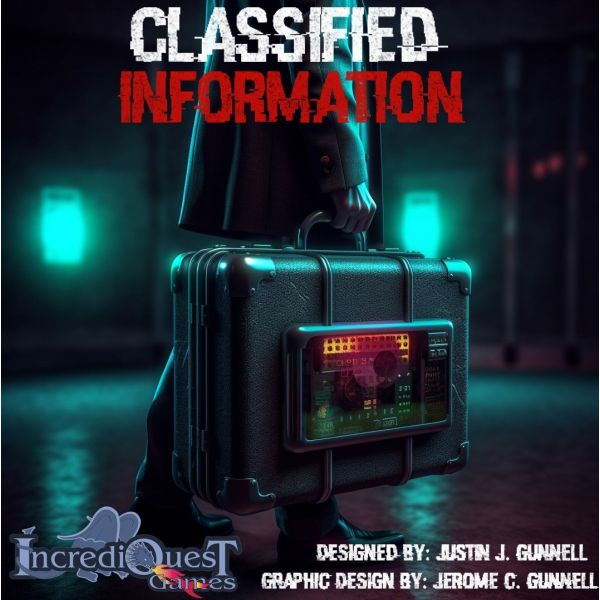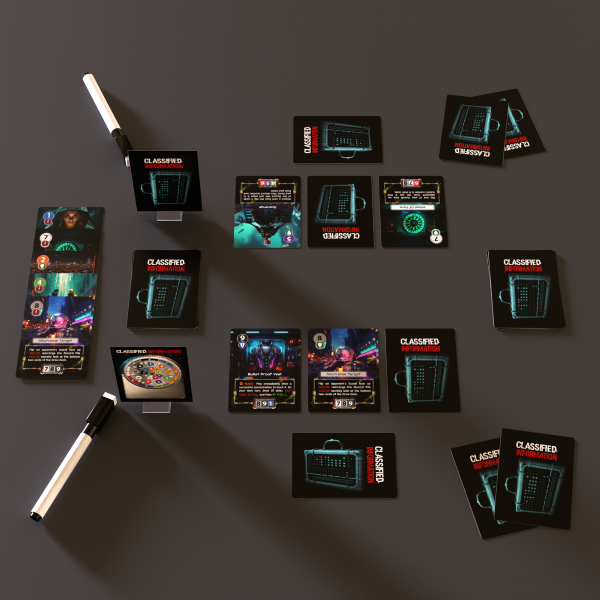Preview: Crack the Code Inside Your Rival's Suitcase in Classified Information

Two rival factions in a cyberpunk universe seek a top-secret code hidden in their opponent’s suitcase. Will you be able to crack the code?
Classified Information is a 2-player deduction game that crams a surprising amount of strategy into a meager 18-card deck. The publisher, IncrediQuest Games, is currently seeking funding for this game on Kickstarter and they sent us a prototype of the deluxe edition to try out.

Sample gameplay rendering (provided by the publisher).
Gameplay
The game contains three separate decks of 18 cards, but only one of these decks is used per game. Players can also choose to mix and match cards to create their own custom deck of 18 cards. The deck is shuffled and two cards are dealt to each player, with an additional card placed sideways to serve as that player’s Suitcase. Two more cards are also placed into the Encrypted Card pile, which will not be seen by either player during the game. A Cypher Wheel card and dry-erase marker are given to each player and the game begins.
Each card contains a number on the top from 1-9 (there are two of each number in the deck). On the bottom of each card is a three-digit secret code that contains consecutive numbers, with the main card number in the middle spot. For instance, if the card is a 3, the code will be 2-3-4; if it is a 9, the code will be 8-9-1 (the 9 wraps around to a 1). Each card also contains a card title, ability, and Guild Affiliation (Guard, Assassin, or Sentinel). The Cypher Wheel card displays a helpful chart of all available cards, along with their secret code and Guild Affiliations.
The goal of the game is to successfully deduce your opponent’s code by simply matching one of the numbers in the secret code of their Suitcase card with the number of the final card held in your hand. However, if they have a Guard in front of their suitcase that matches the number on your final card, you fail.
Turns in this game are very simple: draw a card from the deck and then perform an action by playing a card from your hand. There are three possible actions to choose from:
- Deploy — To deploy a card, simply discard it and perform the ability shown on the card. There are a wide variety of abilities that vary from deck to deck. For instance: force your opponent to tell you a number that isn’t their Suitcase number, exchange a Guard with your opponent or the discard pile, or choose a number and force your opponent to reveal whether their suitcase number is within +/- 2 of the chosen number. Some abilities (labeled with “react”) can be played outside of your turn to block an assassination attempt, for instance.
- Enlist — Enlisting involves playing a card for its Guild Affiliation. A Guard is played face-down in front of your Suitcase to defend it (there can be a maximum of 3 Guards in front of each player, and some abilities will cause Guards to be flipped face-up). An Assassin is used to try to remove one of your opponent’s Guards — this is done by choosing a Guard and comparing the code on the Assassin card with the code on the Guard card. If any of the numbers match, the assassination is successful and both the Guard and Assassin card are discarded. When an Assassin is played on a face-down Guard, the code is secretly compared — if there is not a match in the codes, the Assassin card is discarded and the opponent randomly reveals a card in their hand. A Sentinel can be used as either a Guard or Assassin.
- Encrypt — This involves simply placing a card face-down into the Encrypted Card pile, hiding this card for the rest of the game.
The Cypher Wheel is used to keep track of the cards you have seen or deduced during the course of the game. Players can draw directly on the card with their dry-erase marker (or take notes in some other way). The cards in the discard pile are splayed so that it is easy to see what cards have already been played.
Play continues with each player taking turns drawing and player cards until the draw pile is depleted. At this point, each player takes one final turn without drawing a card. Then, only one card will remain in each player’s hand and the game ends. The final card is revealed, as well as all Guards and the Suitcase card belonging to each player. If your final card number matches any number in your opponent’s Suitcase code, and your opponent has no Guards of this number in play, you win! However, if neither or both players have successfully matched the Suitcase code, then the player with the most Guards wins (or the game is tied if both players have the same number of Guards).

Scan of several actual cards from the prototype game.
Review
We were pleasantly surprised by this game. While there are only 18 cards used in the game, it feels like a bigger game. There is a surprising depth of strategic choices and trade-offs in a short 15-minute time span. The flow of the game is quick and simple: just draw and play a card on each turn. But the depth comes in when diving into the player abilities and Guild Affiliations, which work off of each other in interesting ways.
Each card play involves consideration of important trade-offs: should I keep this card, believing it will crack the secret code at the end of the game? Or, should I play it for an action that would be helpful in this moment? And if I play a card, would it be most helpful to use its ability or its Guild Affiliation?
It is also important to consider that each card played (other than Guards, at first) will reveal more information to your opponent to help them discover what Suitcase card you are holding. Thus, no choice is an easy choice. If you don’t have a great card to choose from, you may want to Encrypt a card instead, to at least hide information from your opponent.
In such a short game, it can be difficult to hone in on the exact card your opponent is holding. However, there are many helpful ways to narrow down the possibilities so you have a good chance of matching at least one of the numbers in the secret code. But you also need to balance this deduction process with offensive and defensive plays to either place Guards or assassinate your opponent’s Guards.
The artwork in this game is gorgeous and really adds to the theme and feel of the game, with different artwork in each deck. The graphic design is also laid out nicely and easy to understand, and the inclusion of the Cypher Wheel cards and dry-erase markers is very helpful to the gameplay. Some beautiful suitcase minis are also included in the game to support a multi-game mode (best of three or five games). On the downside, the prototype rulebook had some alignment issues in the center of each spread that made the text hard to read. This is not a problem in the digital rulebook, however, and we were assured that this would be corrected in the final edition, which will be produced by a different manufacturer.

A rendering of the game box and contents (provided by the publisher).
One of the key selling points of this game is the portability. You could bring along one of the individual decks, contained in a small hookbox, and you have yourself a game you could easily play at a restaurant or while traveling.
With the inclusion of multiple decks, the replayability of this game is also surprisingly high given its compact size. There are a lot of different abilities to experiment with in each deck, and then you can mix and match cards to create many possible combinations. For players who love to dive in to explore how different cards interact, this is a helpful feature.
This game is great for two players, but the components of the game can support a larger group, with up to three different games going on simultaneously. You could even choose to have a mini-tournament with this game. The final edition will include enough Cypher Wheel cards to support this (two per deck), and there is even a digital Cypher Wheel on the publisher’s website to take notes directly on your phone.
While the gameplay itself is quite easy to learn, it will require several plays to fully grasp the depth of the card interactions and abilities. Many players will enjoy this process, but it may be a turn-off for more casual players who are looking for something lighter. Fortunately, the game plays so quickly that many back-to-back plays can fit into a single gaming session.
Classified Information is more than it appears at first glance. If you’re looking for a quick, compact two-player game with great artwork and a lot of depth in card abilities and interactions, this may be the game for you. Be sure to check it out on Kickstarter.
Pros: quick and simple mechanics with surprising depth and strategy, beautiful artwork and design, very portable, highly replayable with multiple decks included
Cons: learning curve for understanding card interactions and abilities, alignment issues in prototype rulebook
Disclosure: This is a paid preview of an unpublished prototype of this game, which is subject to change prior to publication.




